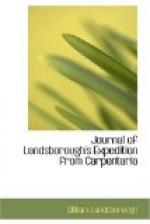The bank on which I marked the tree will, probably at no very distant time, be chosen as the site of a homestead for a sheep establishment, as it is surrounded by fine dry plains which are covered with good grasses, among which I observed sufficient saline herbage to make me feel satisfied that they are well adapted for sheep runs. As the wind was unfavourable during the afternoon the crew had to row down the river. On passing near where we saw the blacks on our way up we found about twenty, counting men, women, and children, waiting to see us as we passed. On the following morning we went ashore and got water in a waterhole near the bank, and also firewood off an old fallen tree, which, I think, is probably the real ebony. Late in the evening we reached a point on the eastern bank about three miles above Kangaroo Point.
We went ashore and in the course of a walk started on the wing two large bustards, and also, within shot of us, two or three wallabies.
In our way up and down the river the temperature ranged on the bar from 74 to 94 degrees. The nights were agreeable, and we were fortunately not troubled with mosquitoes or sandflies.
On the upper part of the river we saw altogether three crocodiles, but they were so shy that they remained in sight only a few seconds.
The slightly timbered downs and plains on the banks of the Albert River are, as I hoped they would be from their western position, of a similar character to good inland settled sheep country of New South Wales and Queensland; the trees that we saw are all small; but as sheep do best in Australia where the temperature is dry, the soil rich, and slightly timbered, and as this is the general description, I believe, of the country and climate of the Albert River, the sheep farmer should be willing to put up with the inconvenience caused from the want of good timber for building purposes.




